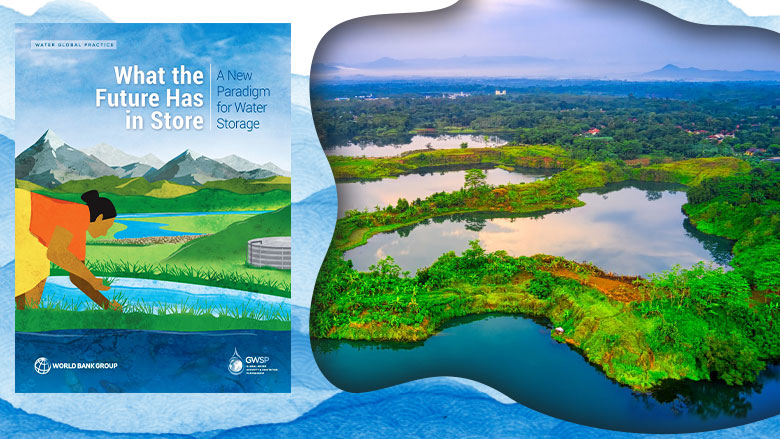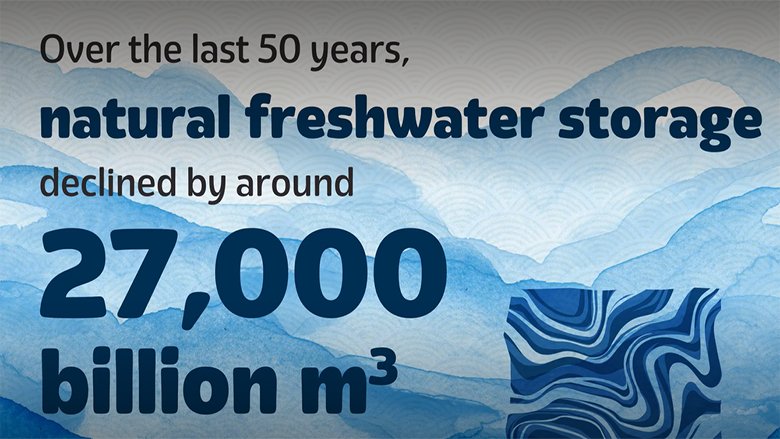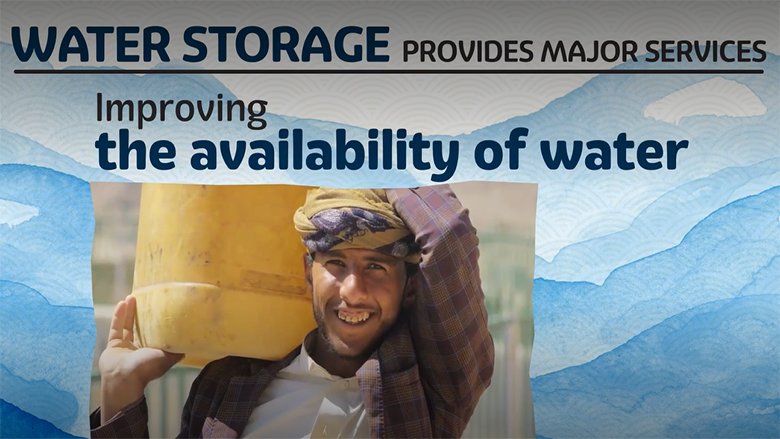What the Future Has in Store: A New Paradigm for Water Storage is an urgent appeal to practitioners at every level, both public and private, and across sectors, to come together to champion integrated water storage solutions—natural, built, and hybrid—to meet a range of human, economic, and environmental needs for the twenty-first century. Closing storage gaps will require a spectrum of economic sectors and stakeholders to develop and drive multi‐sectoral solutions. The proposed integrated water storage planning framework is grounded in sustainable development and climate resilience, with the potential to pay dividends for people, economies, and environments for generations.
Key Messages:
As climate extremes escalate, water storage is becoming an increasingly vital tool for adapting to climate change, as well as other water-related challenges.
• From drought at one end of the spectrum to intense flooding at the other, populations worldwide are experiencing climate events that are leaving a trail of human suffering, economic loss and instability, and environmental destruction in their wake. In some parts of the world, extreme weather is erasing decades of gains in human development in a matter of days.
• Over the past 20 years, 1.43 billion people were adversely affected by drought (Browder et al., 2020). As a result of water scarcity, countries can experience up to 6 percent reduction in growth (World Bank 2016); for the poor, the negative effects can last generations.
• Over the last two decades, at least 1.65 billion people globally have been adversely affected by floods—an increase of 24 percent compared to previous decades (Browder et al. 2021; Tellman et al. 2021; CRED and UNDRR 2020). By 2030, projections suggest an additional 180 million people will be directly affected by flooding (Tellman et al. 2021.)
• Beyond extreme events, climate change is making precipitation less predictable and more variable, making the provision of everyday services such as reliable urban water supply more difficult, farmers less productive, and discouraging economic investment and job creation.
• Water storage provides three major services: improving the availability of water; reducing the impacts of floods; and regulating water flows to support energy, transportation, and other sectors.
• At the same time, the regulation provided by storage can produce clean energy, needed to mitigate climate change. Hydropower generation is also an important complement to other more variable forms of clean energy, balancing their integration into the grid. Finally, pumped storage provides an important source of energy storage.
• Freshwater storage is at the heart of adapting to climate change, most obviously by saving water for drier times and reducing the impact of floods. In the years ahead, the most stable, durable societies will, in many cases, be anchored in more resilient approaches to water storage.
Just as world populations need more storage, the volume of freshwater storage is in decline, creating an international crisis: a global water storage gap.
• Over the last 50 years, the global population has doubled, generating a constantly increasing demand for water and commensurate water storage. Yet the supply of natural water storage has decreased, declining by around 27,000 billion m³ (McCartney, et al. 2022) due to melting glaciers and snowpack, and the destruction of wetlands and floodplains. Concurrently, the volume of water stored in built storage is under threat as sediment fills the useful storage space in reservoirs (Annandale, Morris, and Karki 2016), new construction in some large infrastructure solutions have proven far less sustainable than anticipated, and built structures are aging faster than the pace of rehabilitation.
• Globally, the water storage gap—the difference between the amount of water storage needed and the amount of operational storage (natural and built) that exists for a given time and place—is growing (GWP and IWMI, 2021).
• To address the water storage gap, current approaches to water storage must change; for much of the world, ‘business as usual’ is not a viable strategy. Most often, water storage is evaluated, designed, developed, and managed as independent facilities for specific stakeholders, resulting in siloed arrangements that are unsustainable and inefficient.
• Poor planning of water storage comes with a price. Multiple competing storage systems serve different stakeholders with different services, often separated by borders or boundaries, leading to uncoordinated development or water releases and reduction in total benefits overall. As well, costs, benefits, risks, and uncertainties in advance of investment decisions are not always well understood. As a result, negative impacts on people and the environment are not always minimized and mitigated, and solutions are not developed with an eye towards distributional equity.
• Addressing the global water storage gap is a shared challenge. The challenge is exacerbated by the fact that while water storage is an integrated web of natural and built storage, rarely is it recognized, planned, and managed as a system. Most of the water storage we currently rely on is in nature, and it is not monitored or managed properly; and most shared watercourses lack any legal framework to govern water use.
What the Future Has in Store: A New Paradigm for Water Storage calls for developing and driving multi-sectoral solutions to the water storage gap, taking approaches that integrate needs and opportunities across the whole system, including natural, built, and hybrid storage, to support many instead of few, for generations to come.
• Countries worldwide find themselves in unprecedented situations, struggling to cope with water-related disasters and grappling with how to develop, operate, and maintain water services. This report proposes the purposeful design of water storage solutions that underpin resilient, sustainable, even life-saving storage services that can mitigate the impact of climate-related disasters and close the water storage gap.
• The challenges that beset water storage planning are significant. Most countries have limited resources and must look for efficient approaches to increase their storage capacity. These include leveraging and maximizing natural storage resources; evaluating opportunities for reoperating, rehabilitating, or retrofitting existing storage, raising new, and reform (i.e., investing in institutions to manage storage better); and considering alternatives to storage, ranging from demand management to alternative supply measures for reducing scarcity to zoning regulations.
• Nature is a large part of the solution. More than 99 percent of freshwater storage on earth is in nature, yet it is largely taken for granted. There is a need to collectively recognize natural storage like groundwater, wetlands, glaciers, and soil moisture reserves as fundamental to survival and protect and manage them accordingly. Knowing what we have is the first step toward not taking nature for granted and unnecessarily depleting it, as many parts of the world have been for decades.
• Water storage must be carefully planned. To help address these challenges and others, the report outlines an integrated problem-driven and systems approach to water storage (natural, built, and hybrid), including practical tools—from decision-making under uncertainty to integrated storage planning techniques—that can streamline processes, facilitate collaboration, and ultimately support water practitioners in delivering resilient, sustainable, integrated storage solutions designed to sustain generations.
• More broadly, the report encourages water practitioners at every level to rethink their approaches to developing, investing, and managing storage. From decision‐makers at water ministries and ministries that are water-reliant, to engineers, ecologists, and academics, to project teams at the World Bank and other international development agencies, all have a role to play in adopting and applying the key principles that characterize an integrated approach to storage.
Read the Report Overview
Feature Story: Water Storage is at the Heart of Climate Change Adaptation
Blog: To Meet the Climate Crisis Head-on, Our Approach to Water Storage Must Change


